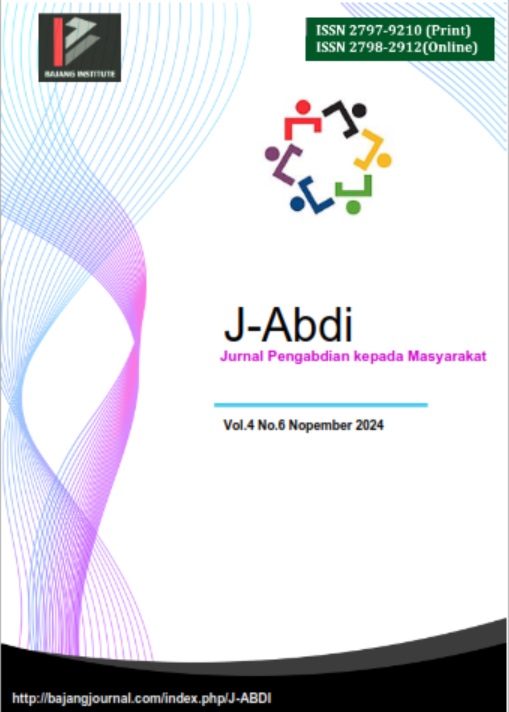PELATIHAN KADER KESEHATAN DALAM DETEKSI DINI DAN PENCEGAHAN STUNTING DI WILAYAH PUSKESMAS KARANG INTAN 2 KABUPATEN BANJAR
DOI:
https://doi.org/10.53625/jabdi.v4i6.8822Keywords:
Cadres, Early Detection, StuntingAbstract
Reducing the prevalence of stunting is a priority of the Sustainable Development Goals (SDG's) in Indonesia until 2030 to reduce as much as 40% of the number of stunted toddlers (Kemenkes RI, 2018; WHO, 2018). The national target for stunting prevalence is set at l4% (fourteen percent) by 2024 (PP RI, 2021). To detect and prevent stunting, cooperation from various stakeholders is needed, especially those related to child nutrition and health. The relevant stakeholders are not only health workers but also health cadres. Posyandu cadres as people who are also close to the community and are an extension of health workers in terms of dealing with maternal and child health problems found in the community can be very strategic to be used as parties who can help overcome the problem of stunting according to their capacity. Based on this, we intend to intervene with health cadres as promoters of stunting prevention and early detection in Karang Intan Sub-district as a sub-district with a high stunting rate in Banjar District. Health cadres will be provided with training, and then they are expected to apply their knowledge to the community, especially prospective mothers, new mothers and mothers with toddlers to care about stunting and prevent stunting
References
Achadi, L. E. (2013) Gizi Ibu dan Kesehatan Reproduksi dalam Gizi dan Kesehatan Masyarakat. Jakarta: Rajawali Press.
Adamson, D. and Bromiley, R. (2013) ‘Community Empowerment: Learning from Practice in Community Regeneration’, International Journal of Public Sector Management2, 26(3), pp. 190–202. doi: 10.1108/IJPSM-08-2011-0105.
Chang, S. et al. (2010) ‘Early Childhood Stunting and Later Fine Motor Abilities’,
Developmental Medicine & Child Neurology, 52(9), pp. 831–836.
Dinas Kesehatan Kabupaten Bogor (2018) ‘Profil Kesehatan Kabupaten Bogor Tahun 2017’. Eko, S. (2002) Pemberdayaan Masyarakat Desa.
Fuada, N., Muljati, S. and Hidayat, T. S. (2011) ‘Karakteristik Anak Balita dengan Status Gizi Akut dan Kronis di Perkotaan daan Pedesaan, di Indonesia (RISKESDAS 2010)’, Jurnal Ekologi Kesehatan, 10(3), pp. 168–179.
Iswati, A., Panuju, D. R. and Wibowo, S. P. (2012) Keterkaitan Antara Penyimpangan Penggunaan Lahan Terhadap Alokasi Ruang Dengan Perubahan Tingkat Kekritisan Lahan (Studi Kasus Kecamatan Babakan Madang dan Klapanunggal). Institut Pertanian Bogor.
Kementerian Dalam Negeri RI (2007) Permendagri RI No. 7 Tahun 2007 tentang Kader Pemberdayaan Masyarakat.
Koelen, M. A. and Lindström, B. (2005) ‘Making Healthy Choices Easy Choices: The Role of Empowerment’, European Journal of Clinical Nutrition, 59, pp. 10–16. doi: 10.1038/sj.ejcn.1602168.
Picauly, I. and Toy, S. M. (2013) ‘Analisis Determinan Dan Pengaruh Stunting Terhadap Prestasi Belajar Anak Sekolah Di Kupang Dan Sumba Timur, Ntt’, Jurnal Gizi dan Pangan, 8(1), p. 55. doi: 10.25182/jgp.2013.8.1.55-62.
Sabaruddin, E. N. (2012) ‘Study on Positive Deviance of Stunting Problems among Under Five Children from Poor Family in Bogor City’.
Shearer, N. B. C. (2009) ‘Health Empowerment Theory as a Guide for Practice’, National Institute of Health Public Access, 23(1), pp. 1–7. doi: 10.1038/jid.2014.371.
Tengland, P. A. (2016) ‘Behavior Change or Empowerment: On the Ethics of Health- Promotion Goals’, Health Care Analysis, 24(1), pp. 24–46. doi: 10.1007/s10728-013- 0265-0.
Thompson, B. et al. (2017) ‘Strategies To Empower Communities To Reduce Health Disparities’, Physiology & behavior, 176(5), pp. 139–148. doi: 10.1377/hlthaff.2015.1364.
Thompson, B. (2017) ‘Strategies To Empower Communities To Reduce Health Disparities’,
Physiology & Behavior. doi: 10.1377/hlthaff.2015.1364.
UNICEF (2013) ‘Improving Child Nutrition: The Achievable Imperative For Global Progress’.
Victora, C. G. et al. (2008) ‘Maternal and Child Undernutrition: Consequences for Adult Health and Human Capital’, The Lancet, 371(9609), pp. 340–357. doi: 10.1016/S0140-6736(07)61692-4.
World Health Organization (2014) ‘Global Nutrition Target 2025: Stunting Policy Brief’.
World Health Organization (2015) ‘Nutrition Landscape Information System (NLiS), Help Topic: Child Malnutrition’














